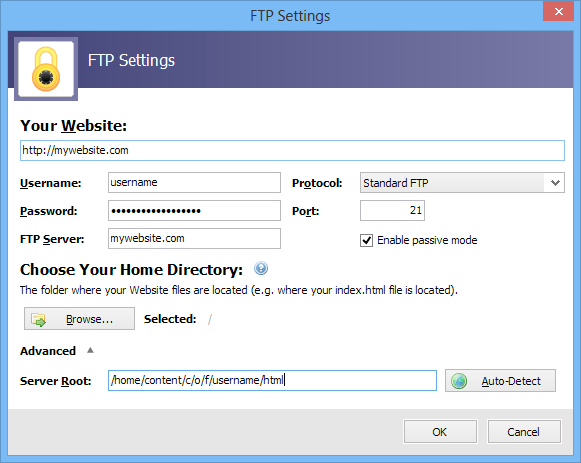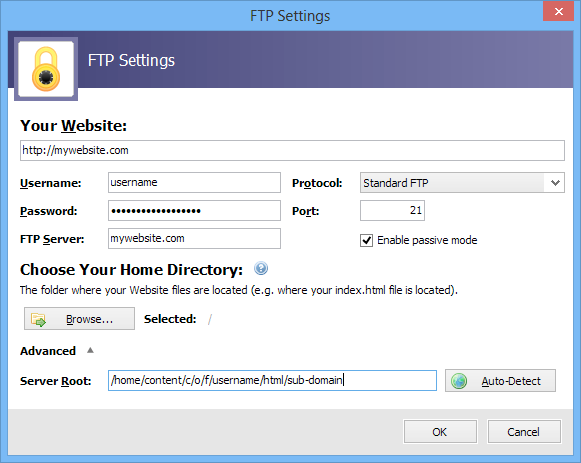What Are the Server Requirements to Use Website Access Manager?
You should be running an Apache or Apache-compatible server (lighttpd and EhttpD work too). The program actually comes with a nifty built-in tool that lets you check to see if your server is compatible. When you open Website Access Manager for the first time, it automatically opens; if you have already started using the program, you can access this tool by going to Tools > Check Server Compatibility. In order to use this tool, your server should have PHP 4.47 or higher installed.
It is extremely important to test your server to ensure that it is compatible with .htaccess. Please note that if you are using a Microsoft-hosted server, you won’t be able to use this program. However, you can contact your hosting provider to see if they can provide an upgrade. We recommend trying the program and testing it thoroughly before purchasing to ensure that it works as intended.
What Web Design Programs Is Website Access Manager Compatible With?
Because Website Access Manager works by adding and modifying .htaccess files, it is compatible with most any web design program, including Visual Site Designer, HTML Editor, and Shopping Cart Creator.
How Many Folders and Files Can I Protect at Once?
There is no limit to the number of folders and files you can protect with Website Access Manager.
How Do I Configure my E-mail Settings?
To configure your e-mail settings, go to Tools > Edit E-mail Settings, and enter the appropriate information in the provided fields. Please note that you should use the e-mail account provided by your web host, such as youraccount@comcast.net or youraccount@aol.com. Other accounts, including Hotmail, Yahoo!, and Gmail, may not work. You should configure the general mail settings the same way you would configure an e-mail program such as Outlook or Thunderbird. If you are unsure of this information, contact the company that provides your e-mail address.
How Do I Add Custom Error Page Themes I Have Downloaded From the CoffeeCup Theme Store?
Follow these steps to install your error page themes:
- Download your themes from your Orders and Downloads page.
- Open Website Access Manager.
- Click the Error Pages button in the Toolbar.
- Click the Add button.
- In the window that appears, browse your computer for the .cct theme file. Select it and click Open.
The theme will now appear in the list in the upper left-hand corner of the Custom Error Pages tab.
My Users See a Login Box Instead of a Custom Error Page. Why?
The short answer: Because your users haven’t logged in yet.
The long answer: Website Access Manager uses .htaccess files to password protect your website. The instructions in these files are read in order, and the first instruction is always going to be to ask for the username and password of any unauthenticated user. If the user doesn’t have these credentials, they won’t be able to access this portion of your website.
Does Website Access Manager Work With Microsoft FrontPage?
If you’re using Website Access Manager to password protect your website, you may experience issues installing Microsoft FrontPage. This is because Website Access Manager uses .htaccess files, and FrontPage interprets non-FrontPage .htaccess files as a security issue, and therefore will not install. If you wish to use FrontPage, you may need to remove your .htaccess file in order to install the software. However, keep in mind that Microsoft has recently discontinued FrontPage, so you may be better off using another web design program.
My Username and Password Are Correct, But I Still Can’t Log In.
Some users who design their websites with Microsoft FrontPage have reported problems logging in with correct username–password combinations. This is because FrontPage automatically creates an .htaccess file that interferes with the code generated by Website Access Manager. There are two ways to get around this issue:
- Configure your FrontPage server extensions to disable the .htaccess feature. If you are unsure of how to do this, contact your hosting provider.
- Manually log in to your server with an FTP client such as Direct FTP or Free FTP and go to the folder you are trying to protect. Locate the .htaccess file and delete the FrontPage code. It looks like this:
# -FrontPage- IndexIgnore .htaccess */.??* *~ *# */HEADER* */README* */_vti*
order deny,allow deny from all allow from all
order deny,allow deny from all
AuthName committees AuthUserFile [path on your server]/_vti_pvt/service.pwd Auth GroupFile [path on your server]/_vti_pvt/service.grpOnce you have removed this information, resave the file, and the password protection should work correctly.
I’m Having Problems Setting up Website Access Manager on a GoDaddy Server.
Although the information in this article is specific to GoDaddy, it can be applied to any hosting provider that uses subdomains of their primary domain. Please also note that GoDaddy users should allow at least an hour for the changes in their first upload to take place. Subsequent uploads are applied immediately.
If you are using GoDaddy, you may experience issues protecting subdomains of your website (e.g. shop.yoursite.com, members.yoursite.com, separate domain names, etc.). This is because GoDaddy reports the same root server path for all folders and subfolders. To work around this problem, you will have to manually enter the subdomain folder you wish to protect. Here’s how:
- Open the FTP Settings window by going to Tools > Edit FTP Settings.
- Click the Browse button to browse for your home directory.
- Append the path in the Server Root field with a backslash and the name of the subdomain folder you wish to protect. For instance, if your server root is:
and the subdomain you wanted to protect was called shop, your server root would look like this:/home/content/m/a/y/maynard/html
/home/content/m/a/y/maynard/html/shop
This is how the FTP Settings window might look before you make this change:

The screenshot on the next page shows how it would look after you have made these changes:

What Are the Limitations of the Trial Version of Website Access Manager?
The trial version of Website Access Manager is the same as the regular version with two exceptions: You may only add 20 users, and the trial expires after 21 days.
Is There a Web Interface for Website Access Manager?
No, there is not. All updates and changes need to be made within the program.
Can I Set up a Webpage Where People Can Register for Access to Password-Protected Parts of my Site?
Sure can! With our powerful Web Form Builder software, you can easily set up a snazzy, personalized registration form for your users. You can add as much or as little information as you like, plus images, additional fields, and more — your only limit is your imagination! When your users send you this information, you can enter it into a user profile in Website Access Manager. Then, using the built-in e-mail function, you can send verification e-mails out to all your users.
Here is a list of helpful articles that we believe can be helpful to you!
- How Do I Know if My Server is Compatible?
- Which Web Design Programs is Website Access Manager Compatible With?
- How Do I Find Out My User Agent?
- How Do I Remove Website Access Manager From My Server?
- What are the Differences Between Website Access Manager and My Server’s Site Control Panel?
- Problems Setting up Website Access Manager on a GoDaddy Server
- Can I Generate New Passwords For All My Users?
- Can I Use Website Access Manager on a Windows Server?
- Can I Add Multiple Users at Once?
- Is There a Web Interface for Website Access Manager?
- How Do I Use Website Access Manager With Visual Site Designer?
- Can I Create a Logout Feature?
- I Get an Error When I Try to Configure My FTP Settings in Website Access Manager
- How Do I Configure the E-mail Settings in Website Access Manager?
- How to Use the Server Settings Tab in Website Access Manager.
- What are the Differences Between Password Wizard and Website Access Manager?
- How Do I Back Up My Databases in Website Access Manager?
- How Do I Block Certain Users From My Site?
- What Are Error Pages, and What Do the Error Codes Mean?
- How Do I Set Up Custom Error Pages?
- Why Can't I See the Folders on My Server?
- How Can I Track Which Users Have Logged in and What Pages or Files They Accessed?
- How Do I Edit Error Page Themes?
- When I Try to Upload, I Get the Message "No Changes Were Detected."
- Can I Import Users From CoffeeCup Password Wizard?
- When I Import a Password File Into Website Access Manager, the Information Appears in the Wrong Fields.
- My Username and Password Are Correct, but I Still Can't Log In.
- Can I Change the Appearance of the Website Access Manager Login Box?
- I Can't Send E-mail With Website Access Manager
- Does Website Access Manager Work Over SFTP or SCP?

